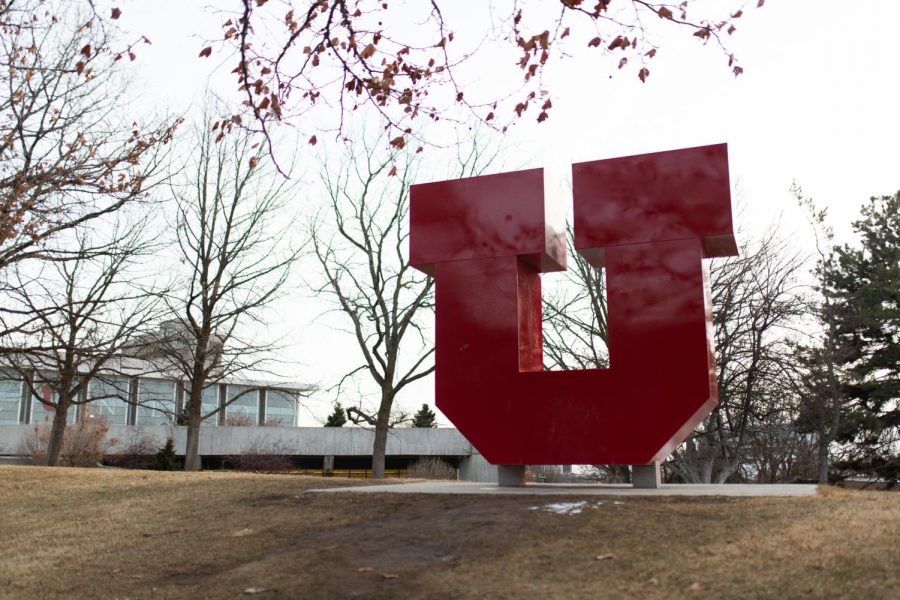CIS-gendered: Names and Pronouns in the Age of Campus Information Systems
Evening on University of Utah campus, Thursday in Salt Lake City. (Photo by Maya Fraser | The Daily Utah Chronicle)
October 5, 2022
When transgender youth are able to use their chosen name in any given space, their risks of depression and suicide decrease. For a community that already faces higher rates of suicidal ideation, honoring someone’s name and pronouns can change these odds.
Since one in four LGBTQ+ youth use pronouns outside of the gender binary, some schools have adapted to incorporate these changes into their campus information systems.
Engendered Systems
In 2009, the University of Vermont became the first school in the nation to allow students to select their pronouns within campus information systems, but only after “nearly a decade of lobbying, the creation of a task force of students, faculty members and administrators, and six months and $80,000 in staff time to create a software patch,” according to The New York Times.
The task force advocated for “they/them” pronouns to be offered in the information system, but that request was vetoed due to faculty deeming it grammatically incorrect — a false notion that has been around since the 1700s. The use of “they” to refer to those who do not conform to the norms of the gender binary, however, can be traced back to a century earlier in medical texts, and even earlier in the writing of Chaucer and Shakespeare.
After UVM’s historic move, schools across the nation created gender-awareness campaigns, leading to a task force “to draft a list of best practices for handling transgender student records.”
Since then, there have been 788 colleges that allow students to elect their chosen first name on campus records and documents, with 242 allowing students to indicate their pronouns on course rosters.
At the University of Utah, students can change their names in most systems without needing a legal change, while they can include their pronouns on their Canvas profile to update their professors’ class rosters.
However, with a lack of inclusivity and communication between information systems, these changes may not be seamlessly carried out.
‘One of the cheapest public health interventions out there’
Lisa Diamond, a U professor of psychology and gender studies, said pronouns are a way to communicate with other individuals and can function as a way to remove uncertainty in social interactions.
She researches social safety — a feeling of social connection, inclusion and protection — all aspects that can be destroyed through stigma.
As a cisgender person, Diamond said sharing her pronouns is not about her.
“It is about making sure that other people know that I know that pronouns can’t be assumed, that people are diverse and it’s an invitation to other people to share their diverse experiences with me,” she said.
“I am here, I exist, this is who I am” — this is the message proudly claimed through names and personal pronouns to Shelby Hearn, the coordinator of education & leadership development at the U’s LGBT Resource Center.
“That’s a super powerful thing to do, to boldly claim your existence,” they said in an email interview. “To use the correct name — and correctly pronounce that name — and pronouns for someone is ultimately about respecting them. Even if you don’t quite understand the way they exist in the world, you can still respect them.”
Diamond said she thinks those with privilege should act to reduce stigma by normalizing the communication of pronouns and making gender-diverse individuals feel included.
“One of the nice things about pronouns is that it sort of communicates a broader kind of awareness of all the different forms of sexual and gender diversity that are out there,” she said. “And so, I think it’s like one of the cheapest public health interventions out there.”
Through her own research, Diamond has seen how stigma contributes to biological changes that can harm health.
“So whenever we do something to broaden the social fabric, to reduce uncertainty and confusion and fear in the minds of other people that are interacting with us about how they’re going to be treated, and whether they can bring [their] full, authentic self to interact with us,” she said. “By doing that, we’re actually fostering health.”
People aren’t mindreaders, so Diamond said rather than make people work to discover if someone is a safe person to bring their full self to, the first step should be to remove the uncertainty right away.
Diamond said this base of social safety can be eroded through misgendering. She added, while it can be repaired, the act of misgendering may feel like the floor dropping out from someone who thought they were safe.
“Even a tiny bit of stigma, or shame or exclusion, can ruin your sense of safety in the same way that a couple of drops of vinegar can ruin a glass of milk,” she said. “It can be really hard to maintain a feeling of safety if you’re on the outs, and it can be lost in a heartbeat.”
Diamond said if a person accidentally misgenders someone else, they should apologize and correct themself, and then follow up privately afterward to give the person some time to share their perspective and feelings about what happened. This is essential for reestablishing safety.
To Hearn, at the heart of transformative education is the student’s ability to fully be themselves. The LGBT Resource Center believes that identity matters in education.
“The U itself values student success, diversity, and community; all of which come back to the importance of respecting people’s pronouns and names,” Hearn said. “When students cannot bring their whole selves to campus, then they can’t succeed, our campus will not be diverse, and we won’t see strong community here.”
Respecting an individual’s name and pronouns is the “tip of a massive iceberg of ways we can be supporting trans folks,” Hearn said — after respect, people should look into other ways they can support the transgender community.
Making the Change
For students who want to change their name and pronouns in university systems, the LGBT Resource Center has a guide to help navigate this.
Hearn said students can change their names in most university systems without having to undergo a legal name change.
“It is, unfortunately, a little tedious, because the variety of systems we have here don’t talk to each other very well, so you do need to go to each area individually to change your name,” they said. “There is a whole breakdown of how to do this for UMail, campus directory, on your UCard, etc. on our website on the Trans At the U page. If a student is told for some reason they cannot change their name, they should reach out to our office and we can help.”
Hearn said students can add their pronouns to their Canvas profile, so they will appear accurately on a professor’s roster. However, the options limit students who use multiple sets of pronouns, as the preset options are “he/they” or “she/they” — this does not permit these gender-diverse students from noting their preference, as these options may not accurately reflect or explain how someone wants others to use their pronouns.
Hearn added you can also always add pronouns in your e-mail signature, your Zoom display name and request they are put on a nametag if you work for a university department.
At any time, students can change their gender identity and sexual orientation information under biographic details on the Student Homepage of CIS.
While the implementation of these system processes was before Hearn’s time at the U, they recognize that any push for inclusivity of trans and gender-nonconforming individuals is typically met with pushback.
“However, most arguments against allowing someone to use a chosen name or have their correct pronouns somewhere don’t hold much water, and while it can be a lot of labor to make changes to the systems we use, it’s worth it for our students to feel like they belong,” they said.
Diamond echoed Hearn’s concerns about computer systems not talking to each other, and questioned how hard it is to fix this problem. If an institution is going to claim to be inclusive of all, then the incorporation of pronouns and name changes into computer systems should not be viewed as an inconvenient obstacle, she explained.
However, what keeps Diamond up at 3 a.m. is the thought that a university or other institution makes the effort to change its systems, but then may not actually work to support and accept gender-diverse individuals.
“Because if the benefit of including your pronouns and sharing them is that it reduces uncertainty in the minds of other people as to how they’re going to be treated, well, if you’re actually not inclusive and accepting, and your use of pronouns is sort of inauthentic, that’s just going to reverse the whole thing,” she said.
Diamond hopes the progress the U has made could be more consistent, especially in regards to the use of technology to be adaptable to student pronouns and names.
If a student has to jump through hurdles to change something affirming to their identity, this can contribute to access fatigue, a phenomenon where those who need access are both teaching others how to participate in access, while also engaging in self-preservation — this fatigue can sometimes be so overwhelming that the individual gives up on fighting for the access they need.
“There are so many things that are protected and … I understand the university needs security, but it can create hurdles to jump through in order to get the changes,” Diamond said. “And one of the things that we know from critical studies and disability studies is that if access to inclusion and equality is really hard to get, that’s not really inclusion and equality, right?”
Navigating Uncertain Terrain
Hearn explained that the LGBT Resource Center is an environment where students are welcome to try on names and pronouns they might not use anywhere else.
“See how it sounds and feels hearing others use the language you’re choosing,” they said. “We have pronoun pins available in the office with a variety of options for you to choose from. And we help educate each other here and keep one another accountable.”
The center also serves as a hub of advocacy and mentorship for students. They can help students navigate telling their family about a new name or draft emails to professors regarding pronouns, among other things.
“We also step in when a student experiences a challenge on campus related to their name and pronouns, advocating for them and ensuring that they are getting the appropriate support across the university,” Hearn said.
To those who view these changes as unnecessary or perhaps don’t understand them, Diamond emphasized it is a privilege to not have to worry about one’s own gender and how one will be treated due to it.
“So you’re a little bit annoyed because this is new to you,” she said. “Just kind of weigh that annoyance against the experience of gender-diverse people who have to navigate this uncertain terrain in each and every social interaction. And imagine how much of that anxiety and uncertainty you can remove with one simple act.”












